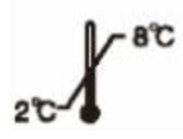Ferritin (FERR)
The Ferritin (Fer) Assay Kit (magnetic microparticle chemiluminescence method) (hereinafter referred to as this kit) is used for in vitro quantitative detection of ferritin (Fer) content in human serum.
Keywords:
Pelvic blood & nutrition
Category:
Pelvic blood & nutrition
Brochure Download:

Tel:
Ferritin (Fer) Assay Kit
Instructions for Use (Magnetic Microparticle Chemiluminescence Method)
Instruction of Ferritin (Fer) Detection Kit (Magnetic Solid Phase Chemiluminescent Immunoassay)
【Product Name】
Generic Name: Ferritin (Fer) Assay Kit (Magnetic Microparticle Chemiluminescence Method)
English Name: Ferritin (Fer) Detection Kit (Magnetic Solid Phase Chemiluminescent Immunoassay)
【Packaging Specifications】
50 tests/box, 100 tests/box, 200 tests/box.
Calibrator: 6 × 0.55mL (optional), 2 × 0.55mL (optional)
Quality Control: 2 × 0.75mL (optional)
【Intended Use】
The Ferritin (Fer) Assay Kit (Magnetic Microparticle Chemiluminescence Method) (hereinafter referred to as this kit) is used for the in-vitro quantitative detection of ferritin (Fer) in human serum.
Used for the diagnosis of iron deficiency anemia in pregnant women, it also plays an auxiliary role in the detection and prognosis assessment of other diseases. Ferritin (Ferritin, Fer) is a high-molecular-weight iron-containing protein with a molecular weight of approximately 460 kDa. Fer is composed of a shell and a core. The shell consists of 24 subunits, called apoferritin. The core is a core containing 4500 iron atoms. Fer is a glycoprotein synthesized in the liver and is the main iron storage protein in the body. Most of the iron in the human body exists in the form of ferritin, and its concentration is often used to evaluate the body's iron storage status. Early iron deficiency does not show obvious anemia. As time goes on, iron stores continue to decrease. Clinically, serum Fer <20 μg/L is used as the diagnostic standard for iron deficiency. If the amount of iron in the human body exceeds a certain amount, it will cause harm. This phenomenon is called iron overload. It is generally believed that Fer >300 μg/L and transferrin saturation >45% can be diagnosed as iron overload. Studies have found that excess iron affects insulin sensitivity, and those with serum Fer >150 μg/L often have multiple factors related to insulin resistance. Iron overload can cause decreased insulin sensitivity, and iron selectively stores in islet cells, causing B-cell apoptosis. When the liver is inflamed, its metabolism is impaired, and serum Fer changes accordingly. Generally, in the acute phase of hepatitis, the active phase of chronic hepatitis, and the active phase of cirrhosis, serum Fer is significantly increased. Moreover, the more severe the liver cell damage, the higher the serum Fer content. In addition, a large number of literature studies have found that the detection of serum Fer in conjunction with other parameters can help monitor tumors, pulmonary tuberculosis, heart disease, and other diseases. A small amount of serum Fer reflects normal iron reserves. Clinically, the detection of serum Fer is an important basis for the diagnosis of iron deficiency anemia. Serum Fer has high diagnostic value for iron deficiency anemia. Compared with the "gold standard" bone marrow iron staining test, serum Fer is mainly characterized by rapid, simple, non-invasive, and no adverse reactions. Common laboratory diagnostic methods in clinical practice include immunochromatography and chemiluminescence methods.
【Testing Principle】
This kit uses a direct sandwich method: Biotin-labeled Fer antibody, acridinium ester (AE)-labeled Fer antibody, and Fer in the sample, calibrator, or quality control are combined to form a "sandwich" complex. Then, add streptavidin-coated magnetic microparticles. Through the specific binding of streptavidin and biotin, the antigen-antibody complex is connected to the magnetic particles. Under the action of an external magnetic field, the complex formed by the immunoreaction is separated from other unbound substances. After washing the complex, add pre-excitation solution and excitation solution. Acridinium ester forms an unstable excited intermediate under the action of pre-excitation solution and excitation solution. When the excited intermediate returns to the ground state, it emits photons, forming a chemiluminescence reaction, which can be used to detect the luminescence intensity of the reaction using a chemiluminescence instrument. Within the detection range, the luminescence intensity is proportional to the Fer content in the sample. The Fer concentration in the sample can be calculated using a four-parameter Logistic equation.
【Main Components】
1. Product Composition
Fer magnetic microparticle reagent: 1 bottle, streptavidin-coated magnetic microparticles;
Fer anti-reagent 1: 1 bottle, biotin-labeled Fer paired antibody conjugate;
Fer anti-reagent 2: 1 bottle, acridinium ester (AE)-labeled Fer antibody conjugate;
Calibrator (optional): 6 bottles or 2 bottles, respectively, containing BSA buffer with different amounts of Fer antigen added. The calibrator value is obtained by scanning the calibrator QR code;
Quality control (optional): 1 bottle each of high and low points, respectively, containing BSA buffer with different amounts of Fer antigen added. The target range of the quality control is obtained by scanning the quality control QR code.
Note ①: Reagents from different batches of kits are prohibited from being used interchangeably.
Note ②: Six calibrator points or two calibrator points can be optionally selected. If calibrators and quality controls have been provided to the user, the kit does not need to be configured repeatedly.
2. Matching Reagents
The following matching reagents are not included in this product but are required for detection:
Pre-excitation solution and excitation solution: Excite acridinium ester to catalyze the generation of photons, so that the luminescence intensity can be detected using a chemiluminescence immunoassay instrument.
Washing solution: Diluted for washing the reaction system.
Source: Provided by our company.
Note: To ensure the accuracy of the test results, the manufacturer of the matching reagents must not be changed arbitrarily during the test.
3. Calibrator Traceability
The calibrator can be traced to the "National Standard Substance for Ferritin (Fer) Immunoassay" provided by the China National Institute for Food and Drug Control.
【Storage Conditions and Shelf Life】
The reagent is stable for 15 months at 2-8℃, protected from light, and should not be frozen.
After opening, the liquid reagent is stable for 30 days at 2-8℃, protected from light.
Production Date
See product label.
Applicable Instruments
Cosmay SMART500S, 6500 or Tuochuang Medical TC-300 fully automated chemiluminescence immunoassay analyzer
Sample Requirements
1. This kit is suitable for serum samples.
2. After blood collection, serum should be separated immediately for analysis to avoid hemolysis. Testing must be completed within 24 hours at room temperature; it is stable for 3 days at 2-8℃ and 30 days at -20℃. Avoid repeated freezing and thawing.
3. Frozen or refrigerated samples should be returned to room temperature and mixed thoroughly before use.
4. Avoid using samples with severe hemolysis or high lipid levels.
5. The sample volume should be no less than 200μL.
Testing Method
Note: Please read the instructions carefully before use. Working conditions: Room temperature (15~35℃); Relative humidity ≤80%.
1. Pre-test preparation
1.1 Before the test, all reagents should be placed at room temperature, and the instrument should be preheated for at least 30 minutes;
1.2 According to the system operating instructions, load the reaction tubes (cups), add or replace the matching reagents, clean the waste liquid and tubes, and perform the liquid path filling operation.
2. Reagent and sample loading
2.1 Before loading the reagents, place the reagents to be used on a mixing device and mix thoroughly. Visually inspect the reagent solution components; they should be clear, free of foreign matter, precipitates, and flocculent matter. The magnetic microparticle reagent should be a uniform suspension without obvious aggregation;
2.2 According to the system operating instructions, scan the reagent barcodes and complete the loading of the magnetic microparticle reagent and the anti-reagent;
2.3 After mixing the calibrators and quality control samples, transfer them to the instrument's dedicated reaction cups and load them into the instrument's sample positions. After scanning, load the centrifuged serum samples directly into the instrument's sample positions.
3. Detection steps
For optimal detection performance, please follow the relevant instructions in this manual and operate according to the fully automated chemiluminescence analyzer operating manual.
Note: The detection reaction process and related parameters have been predefined in the instrument operating software.
4. Calibration curve and calibration
The calibration curve is obtained by scanning the main curve card to generate it directly, or by directly detecting six calibrator points to generate a fit, and the system also supports obtaining a working calibration curve using a two-point calibration method.
Note ①: Due to inter-instrument differences and system differences caused by different operators, operating environments, and matching general reagents, the six-point direct calibration method is recommended to obtain the working calibration curve.
Note ②: Due to reagent activity drift and changes in general reagent batches, the calibrated working curve needs to be recalibrated after a certain period of use. Recalibration should be performed under the following circumstances:
l After 1 month (28 days) of using the same batch number of reagents;
l When using a new batch number of reagents, the whole box or pre-activation liquid and activation liquid;
l When the quality control values are outside the quality control range;
l After each maintenance of the measuring instrument.
5. Result output
The measuring instrument automatically calculates the Fer concentration of each sample using a working curve obtained by two-point calibration from the standard curve, and the results are expressed in ng/mL.
6. Quality control
6.1 Two levels of quality control samples should be determined daily along with sample testing, treating the quality control samples as patient samples;
Note: It is recommended to use at least two levels of commercial quality control products. If the test results are within the system's acceptable quality control range or within your specified range (determined by an appropriate internal laboratory quality control program), the test results are satisfactory; otherwise, the test results are unreliable and a test report should not be issued.
Reference Range
Normal range of this kit: Male: 21.81-274.66 ng/mL, Female: 4.63-204.00 ng/mL.
Note: The Fer levels measured will vary depending on the region, individual, and method used. Therefore, we recommend that each laboratory establish its own normal range. A diagnosis should not be made based solely on the Fer value obtained by this method; the results should be analyzed in conjunction with other clinical data, including the patient's specific condition and treatment status.
Interpretation of Test Results
1. Due to methodological or antibody specificity reasons, testing the same sample using reagents from different manufacturers may yield different results. Therefore, results obtained using different reagents should not be directly compared to avoid erroneous medical interpretation.
2. Test results exceeding the measurement range of the kit are calculated results extrapolated from the calibrator curve. When reporting such results, please pay special attention. If an accurate value is desired, dilute the sample appropriately before testing; the maximum dilution factor is 100 times.
3. Quality control products can serve as a reference for the reliability of the results of the current experiment; their measured values should be within the allowable range specified on the quality control sheet for this batch of products. Test results should be judged comprehensively based on the reference range and other clinical factors and results. When the test result is close to the upper limit of the reference range, consider performing a confirmatory test on the sample.
Limitations of the Test Method
1. Severe hemolysis (hemoglobin ≥500mg/dL), lipemia (triglycerides ≥1500mg/dL), jaundice (bilirubin ≥20mg/dL), and contaminated samples may affect the test results and should be avoided.
2. The test results of this kit are for clinical reference only and cannot be used alone as the basis for confirming or excluding cases. To achieve diagnostic purposes, this test result should be used in conjunction with clinical examinations, medical history, and other examinations.
3. This product can be used for the determination of human serum samples. The reliability of determining Fer concentration in other body fluid samples has not been fully confirmed.
Product Performance Indicators
1. Reagent Performance Indicators
1.1 Accuracy: Within the linear range of the kit, the relative deviation of the determination results of the national standard substance of ferritin (Fer) should be within ±10%.
1.2 Precision: Intra-batch precision ≤8%, inter-batch precision ≤10%.
1.3 Detection limit: Should not be greater than 4.0 ng/mL.
1.4 Linearity: Linear range (4.0~1000.0) ng/mL, correlation coefficient r≥0.9900.
1.5 Specificity: When measuring a 500 IU/mL alpha-fetoprotein (AFP) sample, the measured result should not be higher than 4.0 ng/mL; when measuring 5000 ng/mL human serum albumin, the measured result should not be higher than 4.0 ng/mL.
2. Calibrator Performance Indicators
2.1 Accuracy: Within the linear range of the kit, the relative deviation of the determination results of the national standard substance of ferritin (Fer) should be within ±10%.
2.2 Homogeneity: Inter-bottle difference (CV) ≤8%.
3. Quality Control Product Performance Indicators
3.1 Expected results: The test value should be within ±15% of the target value of the quality control product.
3.2 Homogeneity: Inter-bottle difference (CV) ≤8%.
【Precautions】
1. This reagent is for in vitro diagnostic use only. Reagents from different batches are prohibited from being used interchangeably. Do not use expired reagents.
2. Some components of this kit contain bovine-derived materials, but these raw materials are not from countries or regions with bovine spongiform encephalopathy (BSE) epidemics, and their production is not carried out in countries or regions with BSE epidemics. If it is bovine serum, it will be filtered and sterilized after purchase before being used in kit production. Therefore, the kit does not pose a risk of transmitting BSE; some components of the kit contain porcine-derived materials, but these raw materials are not from countries or regions with foot-and-mouth disease epidemics, and their production is not carried out in countries or regions with foot-and-mouth disease epidemics. If it is porcine serum, it will be filtered and sterilized after purchase before being used in kit production. Therefore, the kit does not pose a risk of transmitting foot-and-mouth disease; this reagent does not contain human serum, but should still be considered a potential biohazard.
3. This reagent contains preservatives. Avoid contact with skin. If skin accidentally comes into contact with the reagent, rinse thoroughly with plenty of water.
4. All reagents should be stored at 2~8℃, avoid freezing at -20℃, and equilibrate to room temperature before use.
5. The magnetic microparticle reagent should be thoroughly mixed before use, and strong shaking should be avoided.
【Explanation of Labels】
 Store at 2-8℃
Store at 2-8℃  Avoid direct sunlight
Avoid direct sunlight  Place upright
Place upright
 In vitro diagnostic reagent
In vitro diagnostic reagent  Production date
Production date  Expiration date
Expiration date
 Product batch number
Product batch number  See instructions for details
See instructions for details
【References】
1. Wang Yanyan. Significance of serum ferritin detection. Journal of Inner Mongolia Medical University, 2015(1):90-92.
2. Wang W, Knovieh MA, Coffman LG, et al. Serum ferritin: Past, Present and future. Biochimicat Biophysica Acta, 2010; 1800(8): 760-769.
3. Ouyang Weifu, Discussion on the diagnostic value of serum ferritin determination for iron deficiency anemia. Journal of Practical Medicine, 2008, 24(23):4127-4128.
4. Zhao Wen, Li Luping, Huang Jing. Clinical significance of serum ferritin, folic acid and vitamin B12 detection in pregnant women at different gestational ages. China Maternal and Child Health Care, 2011, 26(29): 4639.
5. Yan Lingxian, Xiong Yan, Zhang Taiyang, et al. The influence of iron metabolism on carotid atherosclerosis in diabetic patients in Jiangxi Province. Chinese Journal of Diabetes, 2012, 20(5): 343-345.
The clinical significance of vitamin B12 testing China Maternal and Child Health Care, 2011, 26 (29): 4639
5. Yan Lingxian, Xiong Yan, Zhang Taiyang, etc Effect of iron metabolism on carotid atherosclerosis in patients with diabetes in Jiangxi Chinese Journal of diabetes, 2012,20 (5): 343-345
【Basic Information】
Registrant/Manufacturer: Zhejiang Tuochuang Medical Technology Co., Ltd
Address: No. 1 Building, Thousand Talents Plan Industrial Park, No. 78, Zhancheng Avenue, Zhuji City, Zhejiang Province
Production address: No. 1 Building, Thousand Talents Plan Industrial Park, No. 78, Zhancheng Avenue, Zhuji City, Zhejiang Province
After-sales service unit: Zhejiang Tuochuang Medical Technology Co., Ltd
Production license number:
Contact number: 0575-87178692
Fax:
Postcode: 311800
Website: www.zjtcyl.com
【Medical Device Registration Certificate Number/Product Technical Requirements Number】
Manual Approval and Revision Dates
Approval Date:
Revision Date:
Related Downloads
Related Products
Contact Us
Adhering to the user-centric approach, while continuously improving service standards and capabilities, we will remain true to our original aspiration, strive for excellence, and wholeheartedly serve our customers!
Contact Number
Company Address
No. 1, Building 1, No. 78, Zhancheng Avenue, Taozhu Street, Zhuji City, Zhejiang Province

Scan to view on mobile phone
Copyright © 2025 Zhejiang Tuochuang Medical Technology Co., Ltd Powered by 300.cn
